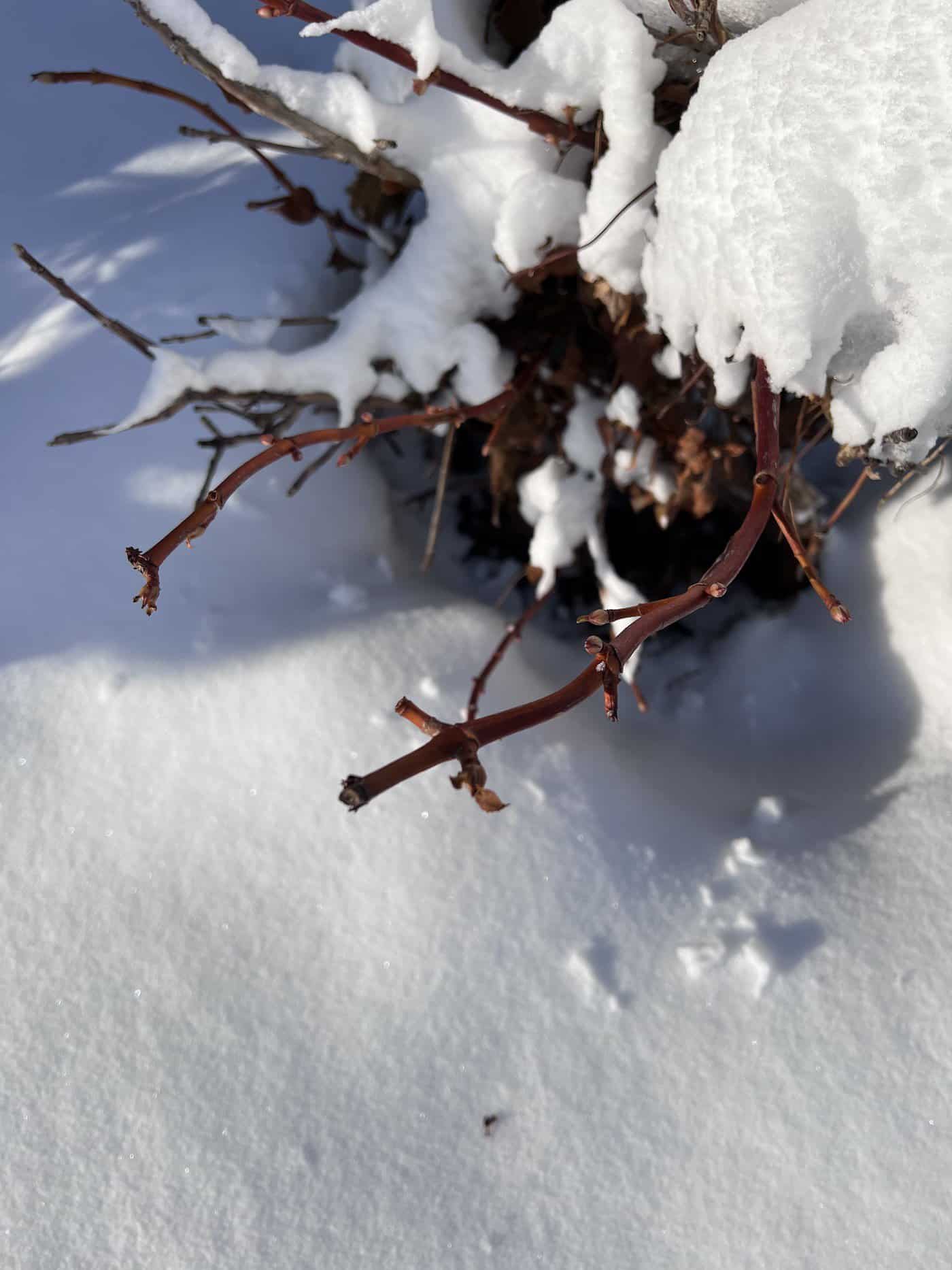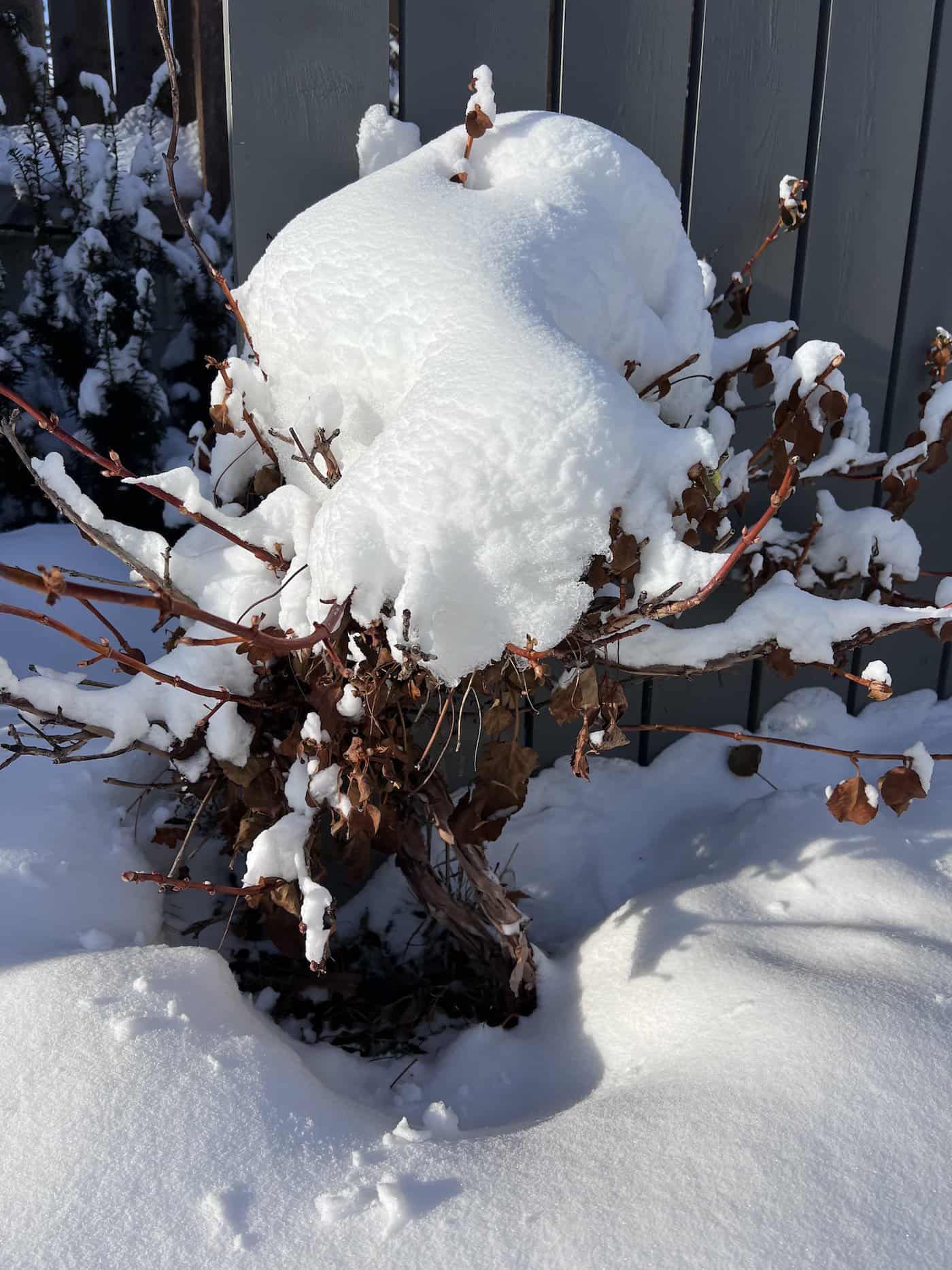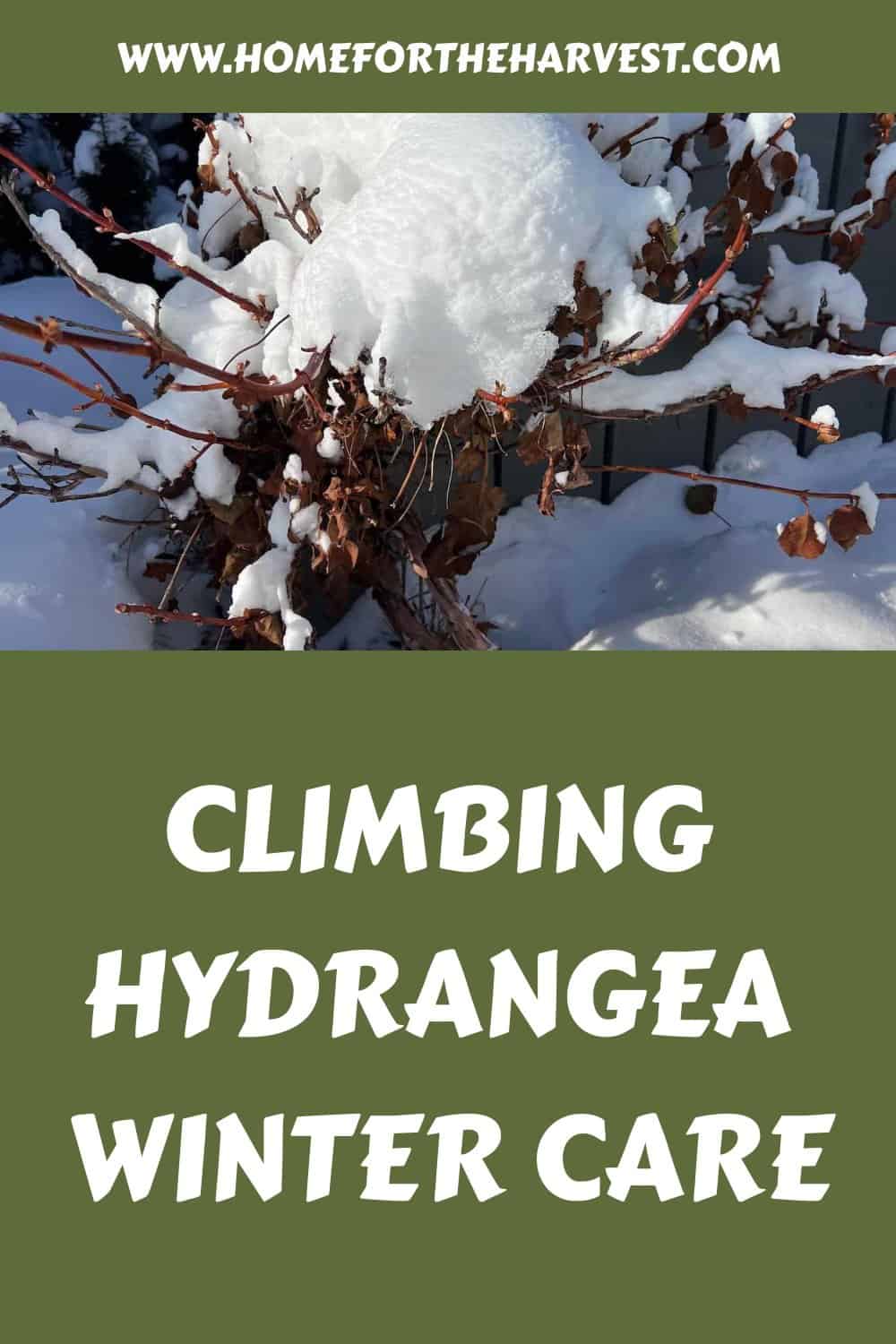The most important climbing hydrangea winter care tasks involve preparing them well for cold, harsh conditions. Water them regularly in the fall and even through winter in locations where the ground does not freeze solid. In particularly cold zones, you can mulch the base of the plant with 6″ of protective winter mulch after the ground freezes. Avoid pruning your climbing hydrangea in the winter or early spring because you will trim off dormant flower buds.
Preparing climbing hydrangeas for winter
Preparing climbing hydrangeas for the winter is all about ensuring they are as healthy as possible in the fall so they can make it through the winter unharmed and ready to sprout and bloom in the spring.
During the fall and winter months, hydrangea plants need less water than they do during the summer. Check the soil to make sure it is not overly dry. Water your plants when necessary, letting the soil dry out a bit between waterings. Watering at the base of the plant is best. If you have a particularly cold winter, try to avoid wetting the leaves of your plant as this can cause them to freeze.
Mulch helps protect hydrangeas from extreme temperatures and also helps retain moisture in the soil. Use an organic mulch such as bark chips or straw around your plants for insulation against frost and temperature swings.
Fertilizing should be done sparingly during the fall and winter months because hydrangeas are dormant in winter and won’t benefit from extra nutrients until springtime arrives. A light fertilizer application can be added in the spring as the soil starts to warm as part of your annual hydrangea care routine.

Watering in winter
Watering in winter is an important part of caring for climbing hydrangeas. While it may seem counterintuitive to water a plant when temperatures are cold, the roots still need moisture to stay healthy and hydrated. The key is knowing how often to water and making sure that the soil isn’t frozen.
During the fall, keep the plant well-watered. Let the soil dry out between waterings, but generally, the soil should be moist. The damp, cool temperatures can encourage fungal disease, so be sure to water at the base of the plant, not the foliage.
When deciding whether or not to water your hydrangea during winter months, you should check the soil first. If it feels dry, then go ahead and give your plant some extra love with a good watering session. However, if the soil is already wet or frozen solid, then skip watering
Remember that even though we may be tempted to neglect our gardens during colder months – they still need us! With just a little more attention now than usual and some warm thoughts, we can ensure our climbing hydrangeas survive another long winter season unscathed and ready for new growth come springtime.
Watering in winter is an important part of caring for climbing hydrangeas, but it’s not the only factor to consider. Next, we’ll look at how pruning and mulching can help protect your plants during colder months.
Mulching around the base of climbing hydrangeas
Mulching is an important part of winterizing the hydrangeas you grow. This includes regular soil surface mulch that stays on year-round and special thick winter protective mulch applied only while the ground is frozen.
Mulch helps to protect the roots from extreme temperatures and provides a layer of insulation that will help keep the soil moist and retain heat. Mulch also helps to suppress weeds, which can compete with your plants for nutrients and water.
When mulching the soil around your climbing hydrangeas, it’s important to use organic materials such as wood chips or bark nuggets. These materials are slow to decompose, so they provide long-term protection for the plant’s root system throughout the winter months. Avoid using synthetic materials like plastic sheeting or tarps because these can trap moisture against the plant’s roots, leading to rot or disease.
For protective winter mulch around the base of the plant in cold areas, the amount of mulch you should apply depends on how cold it gets in your area during the winter months. This base mulch is applied after the ground freezes. Usually, 2-4 inches of mulch is enough for most climates, but if you live in an especially cold region, then 6-8 inches may be necessary. Pile it up around the stem after the ground freezes and remove it promptly in early spring as the ground thaws.
Finally, make sure that whatever type of organic material you choose has been aged properly before applying it, as fresh material may contain weed seeds or other pathogens that could harm your plants when exposed directly to their environment without proper curing first.
Fertilizing climbing hydrangeas
Fertilizing a climbing hydrangea in winter depends upon the local climate. In general, fertilizers are avoided in the fall, never applied on frozen soil, and most commonly applied only in early spring and summer. Skip the fall and winter feeds and wait until spring to feed your hydrangea.
Plant protection climbing hydrangea winter care in cold climates
You can do a few things When protecting your climbing hydrangea from extreme cold temperatures. One of the most effective methods is to cover the plant with burlap or other materials. This will help insulate the plant and keep it warm during colder months. You should also consider using a layer of mulch around the base of the plant for additional protection against frost damage. Additionally, you may want to place stakes in strategic locations around your hydrangea so that you can tie them together and provide extra support if needed.
Not all climates require winter protection for hydrangeas; however, if yours does, then taking these steps is essential for keeping your plants healthy throughout the season. In areas where temperatures drop below zero degrees Fahrenheit (minus 18 Celsius), covering your climbing hydrangea with burlap or another material is recommended before winter sets in. Make sure to use something breathable like burlap as plastic sheeting won’t allow air circulation which could cause mold growth on leaves and stems over time.
In addition to providing physical protection from freezing temperatures, fertilizing your climbing hydrangea before winter arrives will give it an extra boost of nutrients that will help ensure its survival through harsh weather conditions ahead. Use an organic fertilizer such as compost tea or fish emulsion at least two weeks prior to when cold weather usually hits in order for roots and foliage alike get their fill of necessary nutrients before they enter dormancy mode due to cooler temps outside.
Taking proper precautions when preparing climate-specific varieties of hydrangeas for winter helps ensure their health come springtime. By following these simple tips for climbing hydrangea winter care – covering with burlap or other materials, adding mulch around the base, and staking strategically – along with giving them some added nutrition via fertilizer beforehand, you will be able to set yourself up for success when warmer days arrive again soon enough.
FAQs about winter care
What do climbing hydrangeas look like in winter?
Most climbing hydrangeas are deciduous vines, meaning they lose their leaves in the winter. During this time of year, the stems and branches of climbing hydrangeas become bare and can be seen winding up trellises or walls. The bark is usually gray-brown with a slightly rough texture. In late winter to early spring, small buds will start to swell on the stems which will eventually open into white lacecap flowers that bloom until mid-summer.
Do climbing hydrangeas lose leaves in winter?
Most common species of climbing hydrangea, including Hydrangea petioloris, do lose their leaves in the winter. This is a normal part of the plant’s life cycle and should not be cause for alarm. During this time, the vine will enter a dormant state and conserve energy until warmer weather returns in spring. Proper care and maintenance throughout the year will ensure that your climbing hydrangea continues to thrive despite losing its leaves in winter.
Should I cut back a climbing hydrangea?
Climbing hydrangeas rarely need to be cut back severely. If you’re unsure what needs to be trimmed, it’s best to consult an expert before making drastic changes that could damage your plants.
Can you cut a climbing hydrangea back to the ground?
You can cut a climbing hydrangea back to the ground, but this is drastic and should only be done once or twice in a plant’s life (not annually). If the plant is healthy, it will regrow from its root system. This is an effective way of “renovation” pruning and will help promote new growth in the spring.







